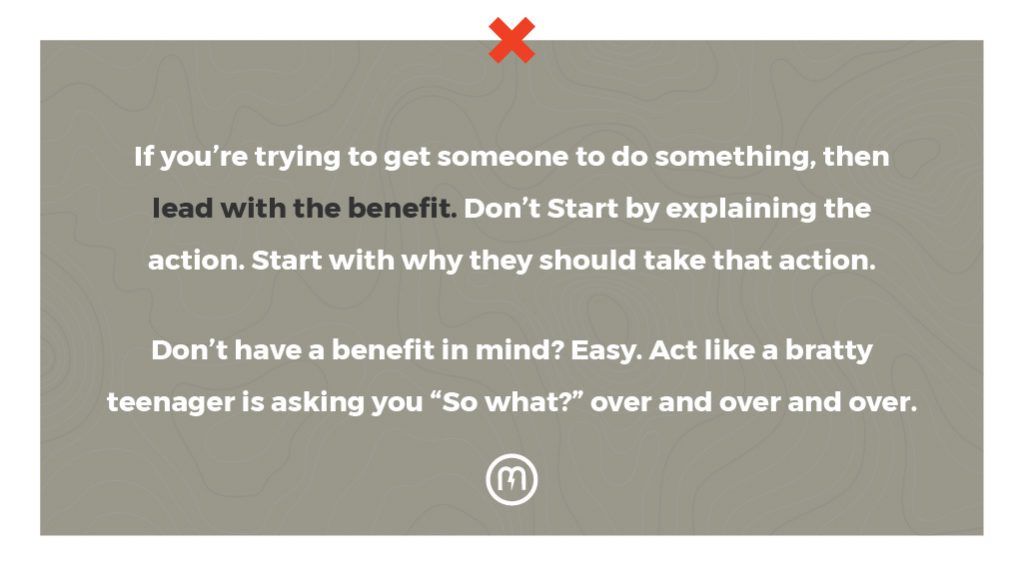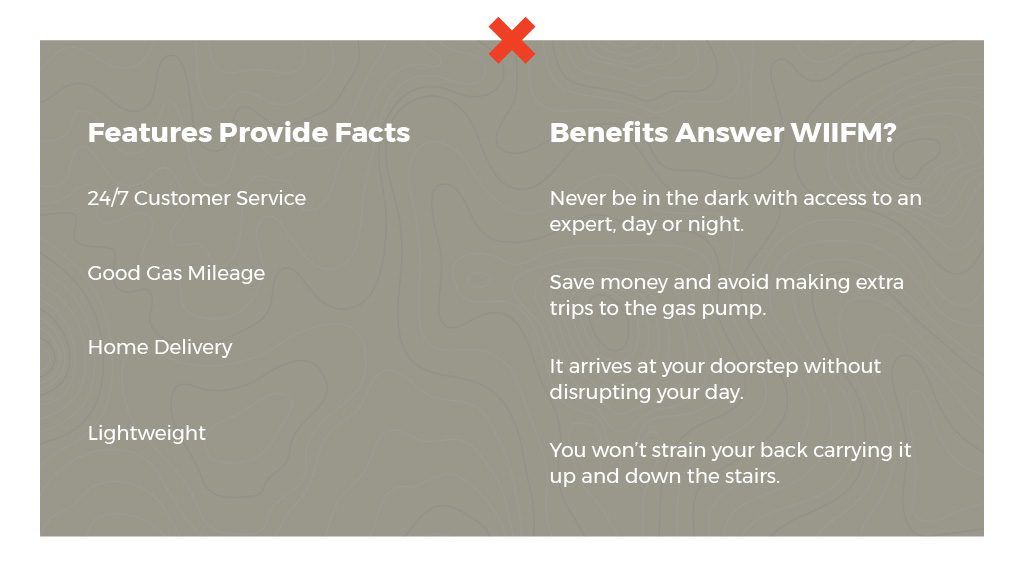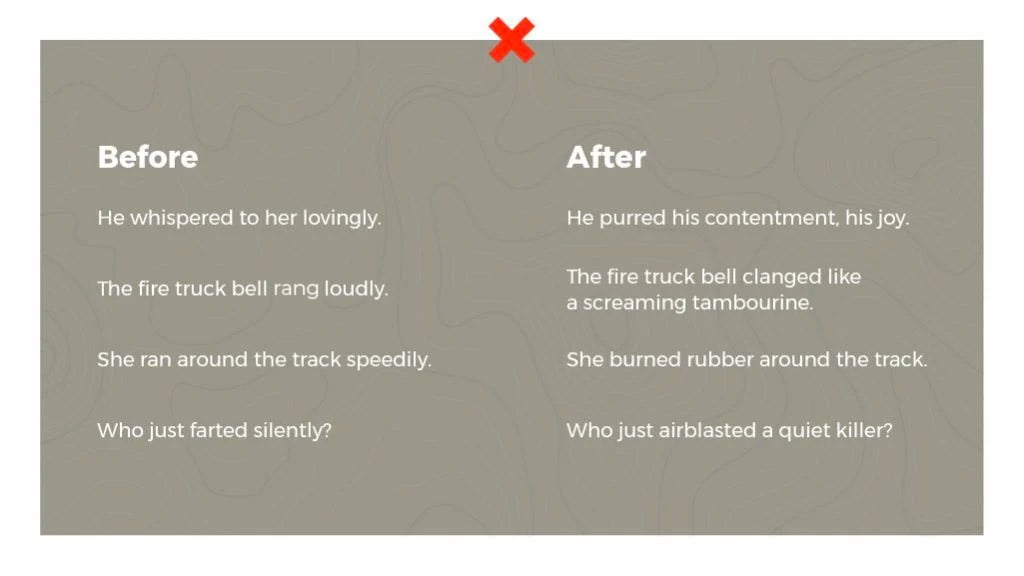“Good writing is not a natural gift. You have to learn to write well.” – David Ogilvy
It’s a comforting thought, isn’t it? That no one is born a poor or prolific writer?
It’s true! Even greats like Ogilvy had to log some serious mileage on their notepads, typewriters, and keyboards to become touted scribes.
But look, we’re all-too-familiar with jam-packed work days and busy evenings. We understand slapping the keyboard for hours on end isn’t in the cards for most.
So with that, we present you with 3 simple copywriting tips to help you become a better writer today.
Related Reading:
How to Develop a Strong Brand Strategy for Your Business
Copywriting Tip #1 – Lead with the Benefit, or Fail to Lead at All
Ready for a harsh truth?
People normally don’t read ad copy.
But when they do, the sole question on their mind is, “What’s in it for me?”—so tell them! Good copywriters anticipate this question and answer it straight away.
What happens, though, if you don’t have a benefit in mind? Or if your benefit is difficult to pinpoint? We have a fix for that:

Pretend like you’re a loving mother who just came home with this shiny new product. You’re so proud of your purchase.
You call your family into the living room to share the exciting news, and then your bratty little teenager chimes in asking “So, what?” over and over again.
For instance…
You: We bought a Dyson vacuum today!
“So, what?” says the little twerp.
You: Well, now we have the suction power of 10 vacuums built into 1.
“So, what?"
You: So now we can clean all that dirt you track in every week.
“So, what?”
You: So that our house doesn’t look like a pig pen.
“So, what?”
“So I can finally feel clean in my own home!”
Bullseye.
The bottom line?
Asking “So, what?” is a sure path to answering “What’s in it for me?” within your copywriting
Treat your readers like the selfish ingrates they are (you’re the exception, of course). Offer concrete examples of how their lives will be better with your product.

Copywriting Tip #2 – Ditch that Lazy Old Adverb for a Younger Word with a Stronger Spine
“I truly believe that this is the best blog I’ve ever read. I think I’ll quickly save this so I can read it again tomorrow.”
Oof. Strike two.
Sometimes writers use long, complex sentences riddled with $5 words to show they went to college. Sometimes they get a little lazy and overuse adverbs. Resist these urges, you snowflake genius.
Related Reading:
Content Marketing Workflow: An Agile Approach to Consistent Results
Clean, purposeful verb choice is one of the quickest ways to bolster your writing.
Concise sentences with sharp verbs not only give your writing more bite and tempo, they also paint a more vivid picture in your reader’s mind.
- Instead of running quickly, you might change it to dashing.
- Instead of walking cautiously, you might choose to tiptoe.
- Instead of jumping spontaneously, you might take a plunge.
Your quest for the right word may lead to a simple word change, or sometimes to a new sentence structure altogether.

“Without a shadow of a doubt, this is the best blog I’ve ever read. I think I’ll bookmark this to read again tomorrow.”
That’s the ticket.
Why lean on adverbs to get your point across, when in fact, the right verb or adjective can do the job better? Next time you’re proofreading, shy away from these little monsters called adverbs. Pick up a thesaurus. The English language is humongous. There’s a more descriptive way to express your message!
Copywriting Tip #3 – Round Up All the Pacifists. Employ Active Voice.
“Every day, the clients’ worries are laid to rest by Magnetic Creative.” – Some unemployed writer
There’s nothing technically wrong with writing this way, but this is advertising! Where’s the sizzle? Let’s break it down…
Why was the road crossed by the chicken?
This sentence is in a passive voice. That means the subject of the sentence (the chicken), is acted upon by the verb (crossed). See how that sounds… weird? Let’s compare that to an active voice.
Why did the chicken cross the road?
This sentence is an example of active voice. An active voice is where the subject (the chicken) performs the action stated by the verb (cross). Active voice has a way of being clearer and more concise.
The action in an active voice sentence feels more present, more effective, more… active!
“Magnetic lays clients’ worries to rest every day, yo!”
That’s what’s up.
Pro Tip:
If you can add “by the chicken” after the verb, then you have a passive sentence.
- The creepy house up on the hill is haunted (by the chicken).
- Slowly and steadily, the nose of the Sphinx had been worn away (by the chicken).
- At last, the quest for everlasting youth will be answered (by the chicken).
Not only is passive voice off-putting, it typically lengthens your sentences and blurs your message.
Don’t lay an egg on your reader. Use active voice.
Bonus! Cliché Mnemonic Copywriting Tips. Kind Of.
Because it wouldn’t be a legitimate how-to-write article without one. So just for good measure, here are:
Three extra down and dirty tips for effective brand copywriting:
K.I.S.S. – Short words, short sentences, and short paragraphs
Just like your 3rd grade teacher used to tell you. Quit wiping boogers and keep it simple, stupid. Short words, short sentences, and short paragraphs are the name of the game.
PROOF – Reread everything you write.
If it’s extra important, have a neighbor look at it. Relying on spell check to improve your writing is like relying on your dog’s sense of humor to make tiramisu.
WRITE – Much like stunting, writing well is a habit.
So while it may not be absolutely necessary to sound like Hemingway in emails, challenge yourself to be intentional about your writing—whatever the forum.
Okay, let’s tie a bow on this thing.
People don’t read great brand copy and say, “Wow! That is an awesome piece of writing.”
They read great copy and say, “Wow! That is an awesome company.”
If you take something away from this article, let it be this: Your readers aren’t out to get you. They aren’t actively critiquing your work. The only way to really blow it is by getting in your reader’s way with clunky writing.
As Ogilvy reminds us though, you have to learn to write well. Lead with benefits, choose your verbs wisely, and use active voice.
By putting these copywriting tips into practice, you’ll reduce the likelihood of disrupting your reader’s train of thought.
Instead, readers will be gobbling up your branded content and asking for seconds.
Now, it’s time to supercharge your copywriting with strategic keyword targeting.
Cruise over to our latest article on LSI Keywords for tips on maximizing your content’s reach via organic search.




Join the Discussion